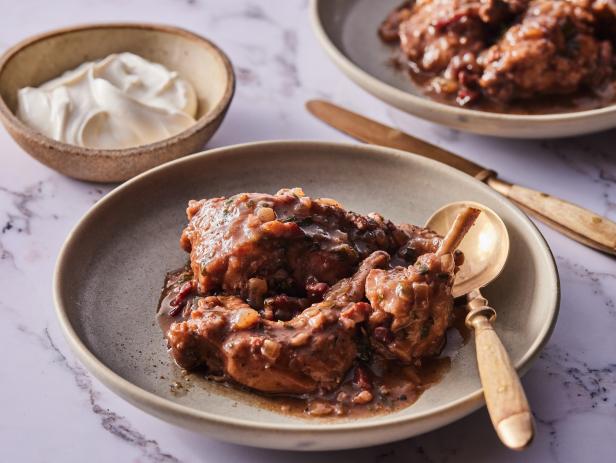This traditional German dish of rabbit cooked in a spiced red wine is usually served with noodles or spaetzle to soak up the rich, tangy sauce. The dish was invented for tenderizing wild hare (hase). This typically gamey meat needed to marinate for several days in a full-flavored wine and vinegar mix, then braise for hours to tenderize it and tame its flavor. Today’s farm-raised rabbits are milder and cook more quickly, but we’ve kept the essence of the traditional version here with an overnight soak in wine, vinegar and whole spices. If you’d like to try this dish but can’t find a whole rabbit, you could also use four rabbit legs or even a cut-up chicken.
| Level: | Easy |
| Total: | 9 hr 45 min |
| Active: | 45 min |
| Yield: | 4 servings |
Ingredients
- 3 cups dry red wine
- 1/2 cup red wine vinegar
- 1 medium onion, cut into chunks
- 5 sprigs fresh thyme
- 4 bay leaves
- 1 teaspoon black peppercorns
- 1/2 teaspoon allspice berries
- 6 juniper berries
- 4 whole cloves
- Kosher salt
- One 4- to 5-pound rabbit
- Kosher salt and freshly ground black pepper
- 1 tablespoon all-purpose flour, plus more for dredging
- 4 ounces slab bacon, cut into lardons
- 1 tablespoon extra-virgin olive oil, plus more as needed
- 1 medium onion, sliced
- 1 cup low-sodium chicken broth
- 1 tablespoon red currant jelly
- 2 tablespoons chopped fresh Italian parsley
- Sour cream, for serving, optional
Instructions
- For the marinade and rabbit: Combine the wine, vinegar, onion, thyme, bay leaves, salt, peppercorns, allspice, juniper, cloves and 2 teaspoons salt in a medium saucepan. Bring to a boil and reduce to a simmer. Simmer over low heat for a minute or two to combine the flavors. Let cool completely.
- While the marinade cools, cut the rabbit into 9 serving pieces: Open up the belly and remove the kidneys and any excess fat. Cut off the front legs at the joint. Cut off the back legs and cut each into 2 equal-size pieces using a cleaver to hack through the bone. Trim the rib cage off and cut the saddle (the midsection of the rabbit) into 3 equal pieces with the cleaver. You should have 9 pieces total. Trim off any excess fat or silver skin from the pieces.
- Put the rabbit in a nonreactive bowl and pour the cooled marinade over it. Weight the rabbit down with a plate, cover and refrigerate for at least 8 hours or overnight.
- For the stew: Strain and reserve 2 cups of the marinade; discard the rest or save for another use. Pat the rabbit dry and season with 1 teaspoon salt and a liberal grinding of pepper. Spread flour in a shallow bowl or plate for dredging the rabbit in.
- Heat a large Dutch oven over medium heat. Add the bacon and cook until crisp, 3 to 4 minutes. Transfer the bacon with a slotted spoon to a paper towel-lined plate to drain. Add the olive oil to the pan. Dredge half of the rabbit in flour and add to the pan. Brown well, about 2 minutes per side. Transfer to a plate. Repeat with the remaining rabbit, adding a little more olive oil if the pan is dry.
- Once all of the rabbit is browned, add the onions to the pan and cook, stirring occasionally, until wilted, about 3 minutes. Sprinkle with 1 tablespoon flour and stir to coat the onions in the flour. Pour in the reserved marinade and bring to a boil. Pour in the broth and adjust the heat so the sauce is simmering. Stir in the reserved bacon and add the rabbit back in one layer. Cover and simmer until the rabbit is tender, 40 to 45 minutes.
- Remove the rabbit and bring the sauce to a boil. Boil until slightly thickened, 2 to 3 minutes. Season with salt and pepper. Whisk in the currant jelly and parsley and add the rabbit back to the sauce. Serve, passing sour cream at the table if desired.
Nutrition Facts
| Serving Size | 1 of 4 servings |
| Calories | 1077 |
| Total Fat | 44 g |
| Saturated Fat | 13 g |
| Carbohydrates | 21 g |
| Dietary Fiber | 4 g |
| Sugar | 6 g |
| Protein | 109 g |
| Cholesterol | 312 mg |
| Sodium | 2073 mg |
